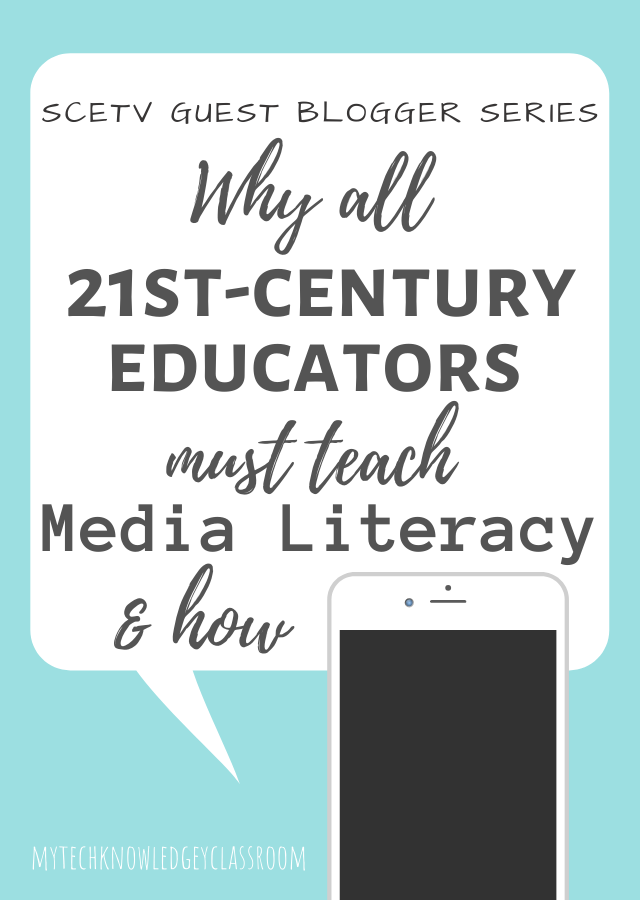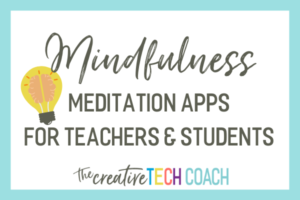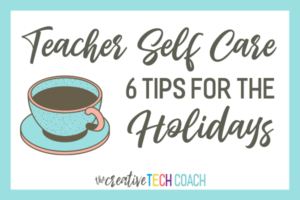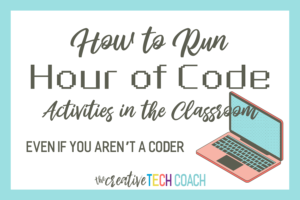Over the summer, my local PBS station, SCETV, asked me to present at their conference, 21st-Century Learners Week. They asked me to talk to other educators about media literacy. While I had done a lot of general digital citizenship instruction for all ages, I had never really focused solely on media literacy. I had to do a little homework, but with the help of online resources like Common Sense Education, I was able to learn a lot and share why teaching media literacy is sooooo important for ALL educators! You can check out what I shared at the conference on my Presentations page.
Because I learned so much from preparing and sharing, I decided to amp up the media literacy instruction at our high school, providing monthly media literacy instruction for students in grades 9-12. So I was really excited when SCETV contacted me again about being a guest blogger for their site. I really felt like I could reach even more educators if I again covered how and why to teach media literacy. Here is the blog post I shared:
With technology being an integral part of classrooms and students’ lives in general, I realize that my job as a teacher involves helping students successfully navigate the online world.
My goal this year is to help every student develop 21st-century skills, including being responsible users of technology and critical consumers of media they encounter.
As a teacher reading this, you are likely integrating digital media in your classroom. I challenge you, too, in the new year to include media literacy as a part of your daily instruction. But you may wonder, “Why should I be responsible for teaching media literacy, and how can I do it on top of an already packed curriculum?”
Why do ALL educators need to teach media literacy?
Linda Ellerbee, host of Nick News (1992-2015), said, “Media literacy is not just important, it’s absolutely critical. It’s going to make the difference between whether kids are a tool of the mass media or whether the mass media is a tool for kids to use.” In other words, do we want students to be manipulated by media, or do we want to empower them to use media?
I firmly believe that it’s every teacher’s job to prepare students to become knowledgeable, productive 21st-century citizens. With tweens and teens spending an average of 6 and 9 hours respectively using media (
Common Sense Media, 2015) — and that’s not including homework! — it’s no longer a question of whether our students will be digital citizens, it’s whether they will be
good digital citizens and digital leaders! With media literacy instruction they can be both!!
Media Literacy and 21st-Century Skills
Teaching media literacy provides students with skills that will help them foremost think critically about media. It also cultivates other 21st-century skills like creativity, collaboration, and communication, as well as increasing digital literacy skills through interacting with media, information, and technology. Media literacy instruction can also help your students develop into active consumers of information, determine credible sources, acknowledge biases in media, and be responsible creators of media.
Whether you teach science, English language arts, social studies or art, there is a place for the development of these skills in your instruction!
But HOW Can Educators Include Media Literacy as an Integral Part of Daily Instruction?!
The
National Association of Media Literacy Education defines media literacy as “the ability to ACCESS, ANALYZE, EVALUATE, CREATE, & ACT using all forms of communication.” Let’s look at some ways educators can help students develop into media-literate individuals.
Access to Quality Sources. We need to ensure students can access quality sources that are current, reliable, and unbiased when they are interacting with media at school.
- Provide students a curated collection of quality resources through links in their learning management systems or tools like Padlet or Waklet.
- Provide access to quality content collections like Pebble Go, Epic!, and NewsELA.
- Teach older students strategies for searching for information. Reach out to your media specialist, and I’ll bet he or she will be happy to help you!
Analyze/Evaluate Using Critical Thinking. But how do students know which sources are credible when the encounter them without our support? Whether they are watching YouTube, reading news, or analyzing images, students need skills to understand information, put it in context, and differentiate between real and fake. One way to do this is to teach students to ask questions when analyzing and evaluating media:
- Who is the author?
- What is its purpose? (inform, entertain, persuade)
- How might different people interpret this message?
- Are there certain groups of people being represented and/or excluded?
- Were certain details left out? Why?
- Also consider: Are sources cited? Are there grammar and spelling errors?
Additionally, giving students the time and opportunity to think for themselves and coaching them on how to ask questions is instrumental for them to learn to analyze and evaluate media on their own.
While teachers must explicitly provide students opportunities to think critically, the critical thinking involved in analyzing and evaluating digital resources should be routinely modeled through teacher think alouds, where students hear, see, and experience this type of thought process.
Creating Media Content. We want to shift from students being solely consumers to being creators who can express themselves through media. When students create media, especially with the questions for analyzing and evaluating in mind, it helps them to consider the impact their creations will have on their audience. Some quality tools for students to use for creating include
Seesaw,
Google Tools,
Canva,
Book Creator, and
Meme Generator.
Distributing Created Messages Responsibly. Besides thinking critically about media, this is probably one of the most important parts of media literacy. We want students to be life-long learners prepared to internalize what they’ve learned about media and transfer it beyond the classroom, including monitoring themselves on social media, being critical of media before sharing it, and empowering them to create and share media responsibly!
Media Literacy Resources to Try Tomorrow
While there are a plethora of resources for teaching media literacy, these tried-and-true resources should help you develop ideas to take back to your classroom and use immediately.
SCETV/PBS Education ResourcesSCETV/PBS Pre-K-12 content like Knowitall, Learning Why, and PBS LearningMedia provide quality media and multimedia resources and lessons for SC students and teachers.
Common Sense EducationCommon Sense Education has free, comprehensive digital citizenship curriculums for K-12 students that include lessons on media literacy.
Google Resources
- Be Internet Awesome, Google’s free digital safety curriculum, helps encourage students to be smart, alert, strong, kind, and brave when online, and has recently added some media literacy lessons.
- Search Education is a series of lessons to help you guide your students to use Google searches meaningfully in their schoolwork and beyond. Choose from Search Literacy lessons and A Google A Day classroom challenges.
- Reverse Image Search can help students determine if images have been altered.
Other Useful ResourcesInteractives like
Factitious and
Bad News help students to better discriminate “fake news” and develop resistance against disinformation.
Check out the original blog post “Why All 21st-Century Educators Must Teach Media Literacy and How” and additional resources at the SCETV website.





